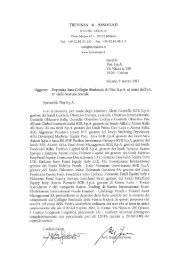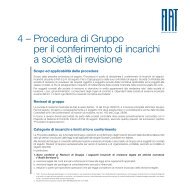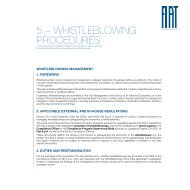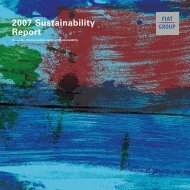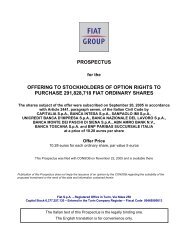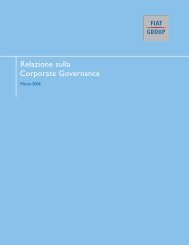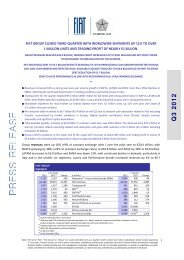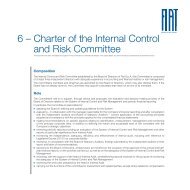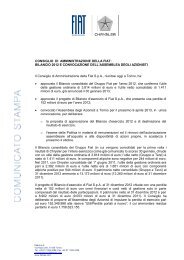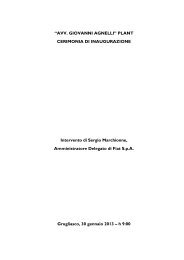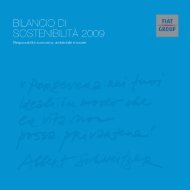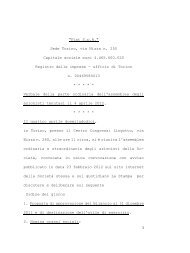annual report - FIAT SpA
annual report - FIAT SpA
annual report - FIAT SpA
Create successful ePaper yourself
Turn your PDF publications into a flip-book with our unique Google optimized e-Paper software.
income on a percentage completion basis, with the incremental portion of the work performed to date being recognized<br />
in the period. The cost-to-cost method is used to determine the percentage of completion of a contract (by dividing the<br />
costs incurred by the total costs forecast for the whole construction).<br />
Any losses expected to be incurred on contracts are fully recognized in the income statement and as a reduction in<br />
contract work in progress when they become known.<br />
Any advances received from customers for services performed are presented as a reduction in inventory. If the value of<br />
advances received exceeds inventory, any excess is recognized as advances under other payables.<br />
Sales of receivables<br />
Receivables sold in factoring transactions are derecognized if and only if the risks and rewards relating to ownership<br />
have been substantially transferred to the buyer. Receivables sold with recourse and without recourse that do not<br />
satisfy this condition remain in the statement of financial position, even if they have been legally sold; in such cases, a<br />
liability for the same amount is recognized for advances received.<br />
Assets held for sale<br />
This item includes non-current assets (or assets included in disposal groups) whose carrying amount will be recovered<br />
principally through a sale transaction rather than through continuing use. Assets held for sale (or disposal groups) are<br />
measured at the lower of their carrying amount and fair value less disposal costs.<br />
Employee benefits<br />
Post-employment plans<br />
The company provides pension plans and other post-employment plans to its employees. The pension plans for which<br />
the company has an obligation under Italian law are defined contribution plans, while the other post-employment plans,<br />
for which the company generally has an obligation under national collective bargaining agreements, are defined benefit<br />
plans. Payments made by the Company for defined contribution plans are recognized as a cost in the income<br />
statement when incurred. Defined benefit plans are based on the employee’s working life and on the salary or wage<br />
received by the employee over a pre-determined period of service.<br />
The scheme underlying the employee severance indemnity of the Italian Group companies (Trattamento di Fine<br />
Rapporto or “TFR”) was classified as a defined benefit plan until 31 December 2006. Legislation relating to this scheme<br />
and leading to this classification was amended by Law 296 of 27 December 2006 (the “2007 Finance Law”) and<br />
subsequent decrees and regulations issued in the first part of 2007. In view of these changes, and with specific<br />
reference to those regarding companies with at least 50 employees, this scheme only continues to be classified as a<br />
defined benefit plan in the consolidated financial statements for those benefits accruing up to 31 December 2006 (and<br />
not yet settled by the balance sheet date), while after that date the scheme is classified as a defined contribution plan.<br />
The company’s obligation to fund defined benefit plans and the <strong>annual</strong> cost recognized in the income statement is<br />
determined on an actuarial basis using the projected unit credit method. The portion of net cumulative actuarial gains<br />
and losses which exceeds the greater of 10% of the present value of the defined benefit obligation and 10% of the fair<br />
value of the plan assets at the end of the previous year is amortized over the average remaining service lives of<br />
employees (the “corridor approach”); the portion of actuarial gains and losses that does not exceed this threshold is<br />
deferred.<br />
Upon first-time adoption of IFRS, the Company elected to recognize all cumulative actuarial gains and losses existing at 1<br />
January 2004 (date of first-time adoption of IFRS by the Fiat Group), despite having elected the corridor approach for<br />
recognition of subsequent actuarial gains and losses.<br />
The expense related to the reversal of discounting pension obligations for defined benefit plans are recognized under<br />
financial expense.<br />
The post-employment benefit obligation recognized in the statement of financial position represents the present value<br />
of the defined benefit obligation as adjusted for unrecognized actuarial gains and losses, arising from the application of<br />
the corridor method and unrecognized past service cost.<br />
Other long-term employee benefits<br />
The accounting treatment for other long-term benefits is the same as that for post-employment benefit plans except for<br />
the fact that actuarial gains and losses and past service costs are fully recognized in the income statement in the year<br />
in which they arise and the corridor method is not applied.<br />
Equity-based compensation<br />
The Company provides additional benefits to certain senior managers and employees in the form of equity participation<br />
schemes (stock options and stock grants). In accordance with IFRS 2 – Share-based Payment, such plans constitute a<br />
Fiat S.p.A. – Statutory Financial Statements at 31 December 2010 267



